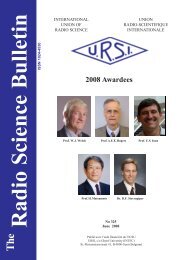Radio Science Bulletin 313 - June 2005 - URSI
Radio Science Bulletin 313 - June 2005 - URSI
Radio Science Bulletin 313 - June 2005 - URSI
- No tags were found...
You also want an ePaper? Increase the reach of your titles
YUMPU automatically turns print PDFs into web optimized ePapers that Google loves.
CPU Time [sec]250200150100MPMSS1SS2jωL /cπ15105MPMSS1SS25005 10 15 20 25 30 35 40 45NSIGFigure 5. CPU time taken by each method for theanalysis of the thin-wire scatterer.square (RMS) error between the original signal andreconstructed signal is also computed.Figure 4 shows that the RMS error (RMSE) decreaseswith the number (NSIG) of damped sinusoids. Since onedamped sinusoid consists of a complex conjugate pole pair,it uses two singular values. Circles represent the resultsjωL /cπ10987654321MPMSS1SS20-1.6 -1.4 -1.2 -1 -0.8 -0.6 -0.4 -0.2 0α L /cπFigure 6. Extracted complex poles for NSIG = 10 of athin-wire scatterer. The x-axis and y-axis represent thereal and the imaginary values of the pole, normalizedwith respect to the length L of the antenna, and c is thespeed of light in free space.0-3 -2.5 -2 -1.5 -1 -0.5 0α L /cπFigure 7. Extracted poles for NSIG = 15 for a thinwirescatterer. The x-axis and y-axis represent thereal and the imaginary values of the pole, normalizedwith respect to the length L of the antenna, andc is the speed of light in free space.using the Matrix Pencil Method (MPM), the asterisksindicate the results for the first State-Space Method (SS1),and the triangles are the results for the second State-SpaceMethod (SS2). For an error threshold of -80 dB, the RMSEsof MPM and SS1 are the same when the error falls below thethreshold, and the transient response is approximated with19 damped sinusoids. The RMSE is the same for eachmethod up through 12 sinusoids; however, for SS2 itdecreases slowly and requires 44 damped sinusoids toapproximate the transient response before it goes below thethreshold. Figure 5 displays the CPU time taken by eachmethod. All simulations have been carried out on the samePC: a 2.4-GHz Intel Pentium IV with 2 GB of RAM.Average CPU times for MPM, SS1, and SS2 respectivelyare 11.4 s, 16.8 s, and 224.8 s. Since the CPU time for theMPM is 68% of that for the SS1 and 5% of that for the SS2,the MPM is the fastest of the three methods.Figures 6 and 7 show the pole plots for NSIG = 10 and15, respectively. Only the node locations in the secondquadrant are shown, because complex poles are symmetricabout the real axis. For NSIG = 10, all poles are the same forFigure 8. Model of aperfectly conducting sphere.The<strong>Radio</strong> <strong>Science</strong> <strong>Bulletin</strong> No <strong>313</strong> (<strong>June</strong>, <strong>2005</strong>) 33
















